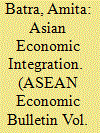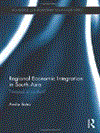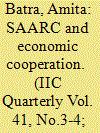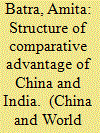| Srl | Item |
| 1 |
ID:
078767


|
|
|
|
|
| Publication |
2007.
|
| Summary/Abstract |
This paper presents the economic rationale for a regional trade bloc in Asia comprising the ASEAN economies, China, Japan, Korea and India, i.e. the ASEAN+4. The inclusion of India in the trade bloc is justified on the basis of increasingly intense trade relations between India and ASEAN+3 and also the increasing importance that India has come to acquire as a market for the ASEAN+3. Alternative approaches to the alignment of ASEAN and the plus four economies for the formation of the ASEAN+4 trade bloc have been evaluated in terms of their efficiency costs. Efficiency costs are determined by the extent of trade distortion and trade diversion implied by each country's participation in the proposed trade bloc. The findings of this analysis underscore the efficiency of a prior alignment with ASEAN for all the plus four economies
|
|
|
|
|
|
|
|
|
|
|
|
|
|
|
|
| 2 |
ID:
173411


|
|
|
| 3 |
ID:
070687


|
|
|
| 4 |
ID:
141531


|
|
|
|
|
| Publication |
Oxon, Routledge, 2013.
|
| Description |
xv, 177p.: figures, tablespbk
|
| Standard Number |
9780415602099
|
|
|
|
|
|
|
|
|
|
|
|
Copies: C:1/I:0,R:0,Q:0
Circulation
| Accession# | Call# | Current Location | Status | Policy | Location |
| 058333 | 337.154/BAT 058333 | Main | On Shelf | General | |
|
|
|
|
| 5 |
ID:
111297


|
|
|
| 6 |
ID:
140042


|
|
|
| 7 |
ID:
137122


|
|
|
|
|
| Summary/Abstract |
Economic cooperation and integration became a part of the SAARC work agenda when the council of ministers of the member countries signed an agreement to form the South Asian Preferential Trade Agreement (SAPTA) in April 1993. The move was prompted by a desire of the South Asian economies to dismantle trade barriers following unilateral trade liberalisation as part of the systemic economic reforms initiated, first, in India, and later undertaken by other economies of the region. The economic reforms set the tone for both, a greater global integration of the South Asian economies as also increased growth momentum in the region. In the subsequent two decades, South Asia experienced high growth averaging over 5 per cent annually accompanied by a rapid pace of trade integration with the global economy. The rate of global trade integration of South Asia was the fastest among all regions in the world between 2005 and 2007.
The Indian economy emerged as the second fastest growing economy in the world. The economic dynamism and rapid global trade integration did not, however, translate into a higher level of economic integration among the South Asian economies; and intra regional trade remained at a low of around 5 per cent of the region’s total trade. The region, endowed with geographical, historical, cultural and linguistic proximity- all parameters that make the member economies the most natural trading partners, is today the least integrated region in the world. The process of economic integration in South Asia is marked by many contradictions. These are discussed below followed by the compelling regional and global imperatives to accelerate the pace of economic integration in South Asia. Finally, sub regionalism is presented as a possible way forward for regional cooperation in South Asia.
|
|
|
|
|
|
|
|
|
|
|
|
|
|
|
|
| 8 |
ID:
080031


|
|
|
|
|
| Publication |
2007.
|
| Summary/Abstract |
This paper investigates the extent of competition between China and India in the world and ASEAN markets. The analysis is undertaken using the concept of revealed comparative advantage, relative market shares, long-term trend analysis and statistical tests of convergence. In the context of the ASEAN market the evaluation of competition between India and China has been undertaken with special reference to the prior implementation of the ASEAN-China Free Trade Area relative to the ASEAN-India Free Trade Area. The results suggest that threat perceptions at the product level might currently prevail for both economies from each other across all sectors in both markets even though the intensity of the competitive threat varies across products. However, long-term trend analysis shows that the patterns of comparative advantage of India and China are evolving along divergent paths and, therefore, competition between the two economies might not be a major issue.
|
|
|
|
|
|
|
|
|
|
|
|
|
|
|
|